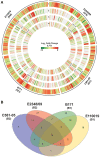RNA-Seq analysis of isolate- and growth phase-specific differences in the global transcriptomes of enteropathogenic Escherichia coli prototype isolates
- PMID: 26124752
- PMCID: PMC4464170
- DOI: 10.3389/fmicb.2015.00569
RNA-Seq analysis of isolate- and growth phase-specific differences in the global transcriptomes of enteropathogenic Escherichia coli prototype isolates
Abstract
Enteropathogenic Escherichia coli (EPEC) are a leading cause of diarrheal illness among infants in developing countries. E. coli isolates classified as typical EPEC are identified by the presence of the locus of enterocyte effacement (LEE) and the bundle-forming pilus (BFP), and absence of the Shiga-toxin genes, while the atypical EPEC also encode LEE but do not encode BFP or Shiga-toxin. Comparative genomic analyses have demonstrated that EPEC isolates belong to diverse evolutionary lineages and possess lineage- and isolate-specific genomic content. To investigate whether this genomic diversity results in significant differences in global gene expression, we used an RNA sequencing (RNA-Seq) approach to characterize the global transcriptomes of the prototype typical EPEC isolates E2348/69, B171, C581-05, and the prototype atypical EPEC isolate E110019. The global transcriptomes were characterized during laboratory growth in two different media and three different growth phases, as well as during adherence of the EPEC isolates to human cells using in vitro tissue culture assays. Comparison of the global transcriptomes during these conditions was used to identify isolate- and growth phase-specific differences in EPEC gene expression. These analyses resulted in the identification of genes that encode proteins involved in survival and metabolism that were coordinately expressed with virulence factors. These findings demonstrate there are isolate- and growth phase-specific differences in the global transcriptomes of EPEC prototype isolates, and highlight the utility of comparative transcriptomics for identifying additional factors that are directly or indirectly involved in EPEC pathogenesis.
Keywords: RNA-sequencing; diversity; enteropathogenic Escherichia coli; pathogenesis; regulation.
Figures






Similar articles
-
Transcriptional Variation of Diverse Enteropathogenic Escherichia coli Isolates under Virulence-Inducing Conditions.mSystems. 2017 Jul 25;2(4):e00024-17. doi: 10.1128/mSystems.00024-17. eCollection 2017 Jul-Aug. mSystems. 2017. PMID: 28766584 Free PMC article.
-
Comparative Genomics Provides Insight into the Diversity of the Attaching and Effacing Escherichia coli Virulence Plasmids.Infect Immun. 2015 Oct;83(10):4103-17. doi: 10.1128/IAI.00769-15. Epub 2015 Aug 3. Infect Immun. 2015. PMID: 26238712 Free PMC article.
-
The Complete Genome of the Atypical Enteropathogenic Escherichia coli Archetype Isolate E110019 Highlights a Role for Plasmids in Dissemination of the Type III Secreted Effector EspT.Infect Immun. 2019 Sep 19;87(10):e00412-19. doi: 10.1128/IAI.00412-19. Print 2019 Oct. Infect Immun. 2019. PMID: 31358567 Free PMC article.
-
[Genes involved in the virulence of enterohemorrhagic Escherichia coli].Nihon Rinsho. 1997 Mar;55(3):641-5. Nihon Rinsho. 1997. PMID: 9086773 Review. Japanese.
-
Typical and atypical enteropathogenic Escherichia coli.Emerg Infect Dis. 2002 May;8(5):508-13. doi: 10.3201/eid0805.010385. Emerg Infect Dis. 2002. PMID: 11996687 Free PMC article. Review.
Cited by
-
Phosphotyrosine-Mediated Regulation of Enterohemorrhagic Escherichia coli Virulence.mBio. 2018 Feb 27;9(1):e00097-18. doi: 10.1128/mBio.00097-18. mBio. 2018. PMID: 29487233 Free PMC article.
-
Genomic, transcriptomic, and phenotypic differences among archetype Shigella flexneri strains of serotypes 2a, 3a, and 6.mSphere. 2023 Dec 20;8(6):e0040823. doi: 10.1128/msphere.00408-23. Epub 2023 Oct 13. mSphere. 2023. PMID: 37830809 Free PMC article.
-
A toolkit for enhanced reproducibility of RNASeq analysis for synthetic biologists.Synth Biol (Oxf). 2022 Aug 23;7(1):ysac012. doi: 10.1093/synbio/ysac012. eCollection 2022. Synth Biol (Oxf). 2022. PMID: 36035514 Free PMC article.
-
Cost effective, experimentally robust differential-expression analysis for human/mammalian, pathogen and dual-species transcriptomics.Microb Genom. 2020 Jan;6(1):e000320. doi: 10.1099/mgen.0.000320. Microb Genom. 2020. PMID: 31851607 Free PMC article.
-
The transcription factor network of E. coli steers global responses to shifts in RNAP concentration.Nucleic Acids Res. 2022 Jul 8;50(12):6801-6819. doi: 10.1093/nar/gkac540. Nucleic Acids Res. 2022. PMID: 35748858 Free PMC article.
References
-
- Abu-Ali G. S., Ouellette L. M., Henderson S. T., Lacher D. W., Riordan J. T., Whittam T. S., et al. . (2010). Increased adherence and expression of virulence genes in a lineage of Escherichia coli O157:H7 commonly associated with human infections. PLoS ONE 5:e10167. 10.1371/journal.pone.0010167 - DOI - PMC - PubMed
-
- Bhatt S., Edwards A. N., Nguyen H. T., Merlin D., Romeo T., Kalman D. (2009). The RNA binding protein CsrA is a pleiotropic regulator of the locus of enterocyte effacement pathogenicity island of enteropathogenic Escherichia coli. Infect. Immun. 77, 3552–3568. 10.1128/IAI.00418-09 - DOI - PMC - PubMed
Grants and funding
LinkOut - more resources
Full Text Sources
Other Literature Sources

